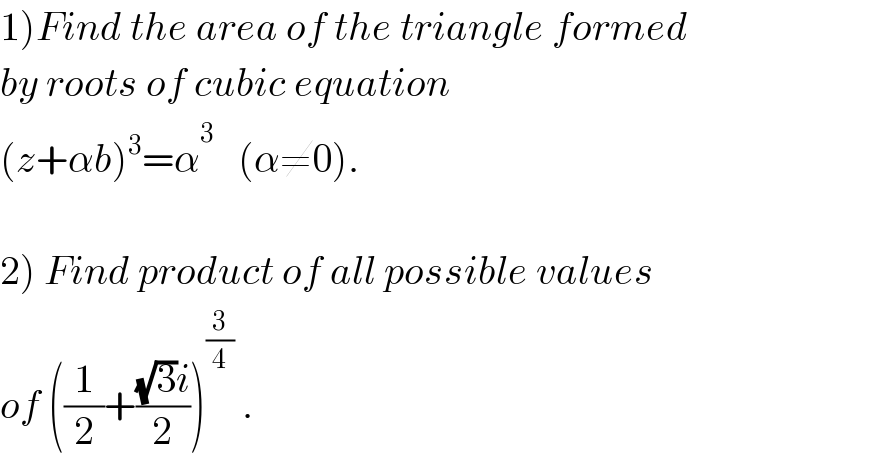
Question Number 49200 by rahul 19 last updated on 04/Dec/18

$$\left.\mathrm{1}\right){Find}\:{the}\:{area}\:{of}\:{the}\:{triangle}\:{formed} \\ $$$${by}\:{roots}\:{of}\:{cubic}\:{equation} \\ $$$$\left({z}+\alpha{b}\right)^{\mathrm{3}} =\alpha^{\mathrm{3}_{} } \:\:\left(\alpha\neq\mathrm{0}\right). \\ $$$$ \\ $$$$\left.\mathrm{2}\right)\:{Find}\:{product}\:{of}\:{all}\:{possible}\:{values} \\ $$$${of}\:\left(\frac{\mathrm{1}}{\mathrm{2}}+\frac{\sqrt{\mathrm{3}}{i}}{\mathrm{2}}\right)^{\frac{\mathrm{3}}{\mathrm{4}}} \:. \\ $$
Commented by rahul 19 last updated on 04/Dec/18

$$\left.{Ans}\rightarrow\mathrm{1}\right)\:\mathrm{1}.\mathrm{3}\:\alpha^{\mathrm{2}} ... \\ $$$$\left.\mathrm{2}\right)\:\mathrm{1}\:... \\ $$
Answered by tanmay.chaudhury50@gmail.com last updated on 04/Dec/18

$$\left.\mathrm{2}\right){another}\:{aporoach}.. \\ $$$$\left(\frac{\mathrm{1}}{\mathrm{2}}+\frac{\sqrt{\mathrm{3}}}{\mathrm{2}}{i}\right)^{\frac{\mathrm{3}}{\mathrm{4}}} =\left({e}^{{i}\frac{\pi}{\mathrm{3}}} \right)^{\frac{\mathrm{3}}{\mathrm{4}}} =\left({e}^{{i}\pi} \right)^{\frac{\mathrm{1}}{\mathrm{4}}} =\left({cos}\mathrm{2}{k}\pi+{isin}\mathrm{2}{k}\pi\right)^{\frac{\mathrm{1}}{\mathrm{4}}} \\ $$$$=\left({cos}\frac{\mathrm{2}{k}\pi}{\mathrm{4}}+{isin}\frac{\mathrm{2}{k}\pi}{\mathrm{4}}\right)={e}^{\frac{{i}\mathrm{2}{k}\pi}{\mathrm{4}}} \\ $$$${so}\:{required}\:{ans}\:{is} \\ $$$${e}^{{i}×\frac{\mathrm{2}×\mathrm{0}×\pi}{\mathrm{4}}} ×{e}^{{i}\frac{\mathrm{2}×\mathrm{1}×\pi}{\mathrm{4}}} ×{e}^{{i}\frac{\mathrm{2}×−\mathrm{1}×\pi}{\mathrm{4}}} ×{e}^{{i}\frac{\mathrm{2}×\mathrm{2}×\pi}{\mathrm{4}}} \\ $$$$={e}^{\mathrm{0}} ×{e}^{\mathrm{0}} ×{e}^{{i}\pi} =\mathrm{1}×\mathrm{1}×\left({cos}\pi+{isin}\pi\right)=\mathrm{1} \\ $$
Commented by rahul 19 last updated on 05/Dec/18

$$\mathrm{cos}\:\pi\:=−\mathrm{1}\:,\:{right}? \\ $$$${So}\:{your}\:{answer}\:{comes}\:{out}\:{to}\:{be}\:−\mathrm{1}... \\ $$$${Thank}\:{you}\:{sir}\:{for}\:{providing}\:{hint}\:{i}\:'{ve}\: \\ $$$$\left.{got}\:{the}\:{correct}\:{ans}.\:{now}\::\right) \\ $$
Commented by rahul 19 last updated on 05/Dec/18

$${You}\:{get}\: \\ $$$${z}=\:\left(\:{e}^{{i}\pi} \right)^{\frac{\mathrm{1}}{\mathrm{4}}} =\left(−\mathrm{1}\right)^{\frac{\mathrm{1}}{\mathrm{4}}} \\ $$$$\Rightarrow{z}^{\mathrm{4}} +\mathrm{1}=\mathrm{0}\: \\ $$$$\therefore\:{Product}\:=\:\mathrm{1}. \\ $$
Commented by tanmay.chaudhury50@gmail.com last updated on 05/Dec/18

$${yes}\:{cos}\pi=−\mathrm{1}\:{typo}.. \\ $$
Answered by tanmay.chaudhury50@gmail.com last updated on 04/Dec/18

$$\left.\mathrm{1}\right)\left({z}+\alpha{b}\right)^{\mathrm{3}} =\alpha^{\mathrm{3}} ×\mathrm{1} \\ $$$$\left({z}+\alpha{b}\right)^{\mathrm{3}} =\alpha^{\mathrm{3}} ×{e}^{{i}\mathrm{2}{k}\pi} \\ $$$${z}+\alpha{b}=\alpha×{e}^{\frac{{i}\mathrm{2}{k}\pi}{\mathrm{3}}} \\ $$$${z}_{\mathrm{1}} +\alpha{b}=\alpha×{e}^{\frac{{i}×\mathrm{0}×\pi}{\mathrm{3}}} =\alpha\left({cos}\mathrm{0}^{{o}} +{isin}\mathrm{0}^{{o}} \right) \\ $$$$\left({x}_{\mathrm{1}} +{iy}_{\mathrm{1}} \right)+\alpha{b}=\alpha\left(\mathrm{1}+{i}×\mathrm{0}\right) \\ $$$$\left({x}_{\mathrm{1}} ,{y}_{\mathrm{1}} \right)=\left\{\left(\alpha−\alpha{b}\right),\mathrm{0}\right\}\leftarrow{A} \\ $$$$ \\ $$$${z}_{\mathrm{2}} +\alpha{b}=\alpha×{e}^{\frac{{i}×\mathrm{2}×\mathrm{1}×\pi}{\mathrm{3}}} =\alpha\left({cos}\mathrm{120}^{{o}} +{isin}\mathrm{120}^{{o}} \right) \\ $$$$\left({x}_{\mathrm{2}} +{iy}_{\mathrm{2}} \right)=−\alpha{b}+\alpha\left(\frac{−\mathrm{1}}{\mathrm{2}}+\frac{{i}×\sqrt{\mathrm{3}}}{\mathrm{2}}\right) \\ $$$$\left({x}_{\mathrm{2}} ,{y}_{\mathrm{2}} \right)=\left\{\left(−\alpha{b}−\frac{\alpha}{\mathrm{2}}\right),\frac{\alpha\sqrt{\mathrm{3}}}{\mathrm{2}}\right\}\leftarrow{B} \\ $$$${z}_{\mathrm{3}} +\alpha{b}=\alpha×{e}^{\frac{{i}×\mathrm{2}×−\mathrm{1}×\pi}{\mathrm{3}}} =\alpha\left({cos}\mathrm{120}^{{o}} −{isin}\mathrm{120}^{{o}} \right) \\ $$$$\left({x}_{\mathrm{3}} +{iy}_{\mathrm{3}} \right)+\alpha{b}=\alpha\left(\frac{−\mathrm{1}}{\mathrm{2}}−\frac{{i}\sqrt{\mathrm{3}}}{\mathrm{2}}\right) \\ $$$$\left({x}_{\mathrm{3}} ,{y}_{\mathrm{3}} \right)=\left\{\left(−\alpha{b}−\frac{\alpha}{\mathrm{2}}\right),\frac{−\alpha\sqrt{\mathrm{3}}}{\mathrm{2}}\right\}\leftarrow{C} \\ $$$${BC}=\alpha\sqrt{\mathrm{3}}\: \\ $$$${perpendicular}\:{distance}\:{from}\:{A}\:{to}\:{BC}\:{is} \\ $$$$\alpha−\alpha{b}+\alpha{b}+\frac{\alpha}{\mathrm{2}}=\frac{\mathrm{3}\alpha}{\mathrm{2}} \\ $$$${so}\:{area}\:{ABC}=\frac{\mathrm{1}}{\mathrm{2}}×\alpha\sqrt{\mathrm{3}}\:×\frac{\mathrm{3}\alpha}{\mathrm{2}}=\frac{\mathrm{3}\sqrt{\mathrm{3}}\:\alpha^{\mathrm{2}} }{\mathrm{4}}=\mathrm{1}.\mathrm{30}\alpha^{\mathrm{2}} \\ $$$$ \\ $$$$ \\ $$$$ \\ $$
Commented by rahul 19 last updated on 05/Dec/18
thank you sir!���� colourful solñ!
Commented by tanmay.chaudhury50@gmail.com last updated on 05/Dec/18

$${your}\:{posts}\:{are}\:{unique}... \\ $$
